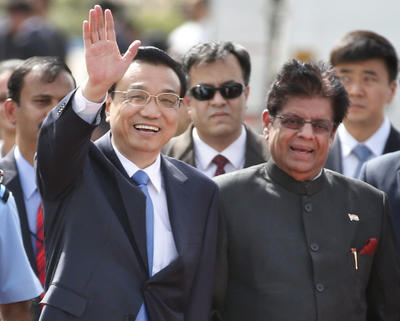As Sourabh Gupta observes in this week’s lead essay, ‘alarmist commentary immediately latched on to familiar tropes of Chinese assertiveness, territorial revisionism and the need for President Xi to establish his hard-line credentials, among others’, when three dozen or so Chinese PLA soldiers, many miles removed from reinforcement or logistical support, pitched their tents in a symbolic assertion of presence at a barren — albeit sensitive — frontier point a dozen miles inside what New Delhi considers to be the Line of Actual Control (LAC) on their disputed border.
The origins of the stand-off in the Ladakh Himalayas, as Gupta explains, appear to have lain in the recent construction of permanent structures by the Indian side at a separate, but similarly sensitive forward observation point, in the disputed western sector of the border. This was a violation, from the Chinese perspective, of long-standing border protocols. The Indian post was in close proximity to an arterial road link (the Aksai Chin highway) connecting Xinjiang to Tibet and prompted Beijing to establish its own presence barely two-dozen miles removed from the strategic China-India-Pakistan border tri-junction area. With both sides having telegraphed their respective strengths and sensitivities, the PLA presence and the Indian construction activity were thereafter withdrawn.
But instead of escalating tensions and a prolonged engagement along what is supposed to be the most dangerous border in the world, the issue was defused by a telephone call from India’s National Security Advisor Shivshankar Menon to his counterpart in Beijing, State Councillor Yang Jiechi (former foreign minister), to the satisfaction of both sides. The warming of India–China relations has seen the institutionalisation of crisis communications channels. They functioned as they were planned to: activation of the prime ministers-level hotline was not required. There was exemplary patience and sensitivity all round in acknowledging the shared nature of the strategic vulnerabilities along the Sino-Indian frontier. Not, as Gupta observes, that this episode is likely to have been accidental: rather it was likely a sophisticated probing of positions, with Beijing particularly aiming to politically test the Singh government’s commitment to Sino–Indian relationship management.
‘Both India and China’, Gupta argues ‘remain conspicuously committed to an alternative model of international relations that is open, pluralistic and non-interventionist in its conception and eschews the imposition of bloc-based approaches or closed-ended arrangements’.
India is now more often than not taken for granted in the West, seen as a pawn in the growing power game between America and China, or so pre-occupied within its region as to stunt its potential global role. There remain expectations that India would fall into defence alignment with the United States on China. India and the United States sorting out their relations under President George W Bush contributed to that way of thinking. The idea that India will seek to forge a ‘natural alliance’ of democratic states in the Indo-Pacific — an idea of two oceans in search of a continent and curiously resurrected in the latest Australian Defence White Paper — framed in conscious contra-distinction to China and India’s regional interests is remarkably persistent, though clearly wide of the mark. More likely it will seek to articulate an alternate, pan-Asian model of international relations that is keyed to regional tradition and historical circumstance and driven at its core by shared Sino–Indian interests. Strategic autonomy is the organising concept in Indian diplomacy. China’s and India’s political and strategic interests are not so differently aligned vis-à-vis those of the US as some might imagine or wish.
Certainly the agenda for Li’s visit to New Delhi suggests that India and China mean business in the development of the common strategic interests in their relationship.
As well as issues of trust-building and the intensification of strategic communication, Indian prime minister, Manmohan Singh, will also be looking to recast and expand their economic relationship, a growing anchor of India–China relations that has underpinned the broader relationship and strategic engagement, and buttressed it against competitive rivalries.
The economics are driving India and China closer together — not further apart. India will be looking for concessions and initiatives from China on market access for Indian IT and pharmaceutical companies. Bilateral trade has surged to over US$70 billion, with both sides setting an ambitious target of scaling it up to $100 billion by 2015. Both sides see this as a target that can be achieved, although India will focus on delivery on Beijing’s promise to address the bilateral trade deficit – which has ballooned to around $39 billion – by extending greater market access to Indian companies and expanding Chinese investment in India. The Chinese side will be looking for India’s nod for allowing Chinese investment in high-speed railways. More broadly, there have been pre-visit discussions on the issues associated with India’s concerns over the construction of three dams on the Brahmaputra River by China.
Premier Li’s visit to New Delhi, and the follow-up visit to Beijing by Prime Minister Singh to Beijing later this year bespeak a deepening relationship between the two emerging powers, and a soaring new diplomacy in the region that could leave traditional ways of thinking about Asian politics behind, in its slip stream.
Peter Drysdale is Editor of the East Asia Forum.

